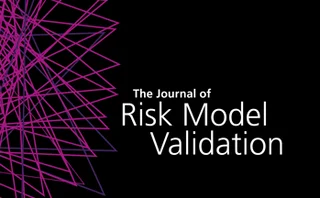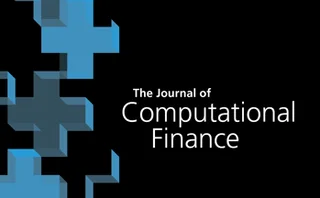Original research
Tail protection for long investors: trend convexity at work
In this paper, the authors show that single-asset trend strategies have built-in convexity, provided their returns are aggregated over the right time scale, ie, that of the trend filter.
Speed and dimensions of trading
In this paper, two new portfolio statistics are introduced: ENT, which measures trading speed, and ENTD, which measures trading diversity. Together with vectors representing major trading directions, these provide new insight into the intrinsic…
Identifying complex core–periphery structures in the interbank market
This paper proposes a framework to identify the structure of a financial network and its evolution over time, and presents an application to an interbank market with complete actual data.
Issuer bias in corporate ratings toward financially constrained firms
This paper considers whether the rating agency attempts to mitigate the feedback effect through its rating actions. Using Moody’s issuer ratings over 1982–2009, the paper shows that firms with greater external financing constraints are less likely to be…
Optimal intraday power trading with a Gaussian additive process
This paper studies the problem of a financial agent wishing to maximize a constant relative risk-aversion expected utility of their terminal wealth while operating in an ID market.
A vine copula–GARCH approach to corporate exposure management
This paper applies vine copulas with GARCH marginals to the problem of capturing asset dependence and tail dynamics for currency and commodity exposures commonly found in portfolios of global corporates.
A model for the valuation of assets with liquidity risk
This paper describes a model for the valuation of assets on a bank balance sheet with liquidity risk. It applies the model to single cashflows, loans, bonds and derivatives. In addition, the calibration to London Interbank Offered Rate basis spreads is…
An enterprise perspective of performance attribution: introducing the keel model
In this paper, performance attribution is extended to an enterprise level based on the keel model. The keel model introduced here is applied to the problem of attributing enterprise value changes to various risk factors.
Determinants of foreign exchange risk: some further evidence
This paper employs the quantile regression model to examine Taiwanese companies and considers factors that researchers have identified which may influence orientation divergences for robustness testing.
New historical bootstrap value-at-risk model
This paper presents a new value-at-risk (VaR) model for the estimation of market risk in banks and other financial institutions.
Pricing multidimensional financial derivatives with stochastic volatilities using the dimensional-adaptive combination technique
In this paper, the authors present a new and general approach to price derivatives based on the Black–Scholes partial differential equation (BS-PDE) in a multidimensional setting.
Volatility risk structure for options depending on extrema
In this paper, the authors give a decomposition formula to calculate the vega index (sensitivity with respect to changes in volatility) for options with prices that depend on the extrema (maximum or minimum) and terminal value of the underlying stock…
Cumulative prospect theory and mean–variance analysis: a rigorous comparison
This paper proposes a numerical optimization approach that can be used to solve portfolio selection problems including several assets and involving objective functions from cumulative prospect theory (CPT).
A hybrid tree/finite-difference approach for Heston–Hull–White-type models
In this paper, the authors study a hybrid tree/finite-difference method, which allows us to obtain efficient and accurate European and American option prices in the Heston–Hull– White and Heston–Hull–White2d models.
Standardized measurement approach extension to integrate insurance deduction into operational risk capital requirement
The SMA proposed in BCBS (2016) presents several issues: in particular, its two components are not sufficient to discriminate banking institutions by risk profile, thus penalizing the more virtuous ones. This paper describes a possible solution to extend…
Efficient trading in taxable portfolios
This paper determines life-cycle trading strategies for portfolios subject to the US tax system.
Exploration risk in international oil and gas shareholder returns
This paper focuses upon the oil and gas industry, examining the association between exploration activity risk and company shareholder returns.
Portfolio concentration and equity market contagion: evidence on the “flight to familiarity” across indexing methods
This paper sheds light on the entanglement of index weighting schemes.
A Darwinian view on internal models
In this paper, Paul Embrechts reviews discussions on regulation within banking (Basel III and IV) and insurance (Solvency II and Swiss Solvency Test (SST)) from a historical, personal and academic point of view.
Risk management and regulation
The author presents a systematic review of the chronological evolution of risk management, in tandem with financial innovation and methodological advances in derivatives pricing.
Derivatives pricing under bilateral counterparty risk
The authors consider risk-neutral valuation of a contingent claim under bilateral counterparty risk using the well-known reduced-form approach.
Networks of log returns and volatilities of international stock market indexes
In this paper, the author builds dynamic networks based on correlation and transfer entropy, using both the log returns and the volatilities of 97 stock market indexes from various parts of the world between 2000 and 2016
Systemic risk management in financial networks with credit default swaps
In this paper the authors study insolvency cascades in an interbank system, in which banks are permitted to insure their loans with credit default swaps sold by other banks.
Lifecycle investing with the profitable dividend yield strategy: simulations and nonparametric analysis
Using simulations, the author shows that life-cycle investing implemented on highly profitable and high dividend yield stocks (the profitable dividend yield strategy) provides a compelling solution to the suboptimality problem by leveraging on the…







